#Earth Observation Satellites
Explore tagged Tumblr posts
Text
Los satélites se consolidan como tecnología líder en adaptación al cambio climático
Continue reading Los satélites se consolidan como tecnología líder en adaptación al cambio climático
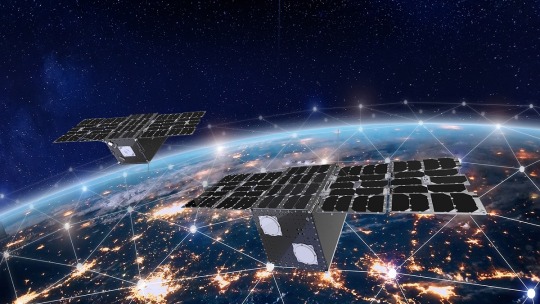
View On WordPress
#Banda Ku#cambio climático#Clima#Desastre Natural#Earth Observation Satellites#Foro Económico Mundial#GCA#IPCC#Otis#Redes móviles#Satélites#Sencinet#Sergio Knust#Tecnología satelital
0 notes
Text
Earth Observation Satellites
Introduction Earth observation satellites are spacecraft designed to observe and gather data about the Earth’s surface, atmosphere, and other environmental features. These satellites use sensors and instruments to collect data across a range of wavelengths and frequencies, including visible light, infrared radiation, and microwave radiation. Earth observation satellites are used for a variety of…

View On WordPress
#Earth Observation Satellites#Earth Observation Satellites Applications#Geographic Information System#Geography#GIS#Remote Sensing and Digital Image Processing (DIP)
0 notes
Text
Satellites: Their Orbits, Tracking Systems, and Essential Uses

Satellites: Their Positions, Tracking, and Importance
Satellites have become an essential part of modern life, orbiting Earth and providing us with services ranging from communication and navigation to weather forecasting and space exploration. As of 2024, thousands of active satellites are circling our planet, each performing a specific role to enhance the quality of life on Earth. This article delves into the positioning of satellites, how they are tracked, what they track, and the significance of their roles.
Types of Satellite Orbits and Their Positions
Satellites are positioned in various orbits depending on their intended functions. These orbits determine how close the satellite is to Earth, how fast it moves, and what areas it covers.
Low Earth Orbit (LEO): Altitude: 180 km to 2,000 km Satellites in LEO include most Earth observation satellites, the International Space Station (ISS), and some communication satellites. These satellites are closer to the Earth, enabling them to capture high-resolution images. Functions: Used for imaging, remote sensing, and some communication purposes. Examples: ISS, Earth observation satellites like Landsat.
Medium Earth Orbit (MEO): Altitude: 2,000 km to 35,786 km Satellites in MEO are mainly used for navigation. This orbit offers a good balance between coverage and latency. Functions: GPS satellites and other global navigation systems. Examples: GPS, GLONASS, and Galileo satellites.
Geostationary Orbit (GEO): Altitude: 35,786 km above the equator Satellites in GEO move at the same rotational speed as Earth, meaning they stay fixed over one location on Earth. These are mostly communication and weather satellites. Functions: Used for television broadcasts, weather monitoring, and some types of communication. Examples: Weather satellites (GOES series), telecommunication satellites.
Highly Elliptical Orbit (HEO): Orbit shape: An elongated orbit with one point closer to Earth (perigee) and another point much farther away (apogee). Functions: Ideal for regions at high latitudes, providing prolonged coverage over areas like Russia and parts of Canada. Examples: Molniya satellites for communication in Russia.
How Satellites Are Tracked
The sheer number of satellites in space, combined with space debris, means tracking them is essential to avoid collisions and ensure their functionality. Ground stations and dedicated space agencies continuously monitor satellites. Several methods are used to track satellites:
Radar and Ground-Based Systems: Ground stations use radar to track satellites in LEO. These systems bounce radio waves off the satellite and measure the time it takes for the signal to return. By doing this repeatedly, they can track a satellite's location and speed.
Global Positioning System (GPS): Satellites in higher orbits like MEO or GEO are tracked using onboard GPS receivers. GPS helps calculate the satellite’s position and relay that data back to Earth.
Optical Tracking: Telescopes and cameras are used to visually observe satellites in higher orbits. This method is particularly useful for tracking objects that do not emit radio signals or need to be monitored for their physical characteristics.
Space Surveillance Networks: Agencies such as the U.S. Space Surveillance Network (SSN) and similar organizations in other countries continuously monitor satellites and space debris. They catalog objects and issue alerts for potential collisions.
What Satellites Track
Satellites are equipped with various sensors, cameras, and instruments to track a wide array of data on Earth, in space, and beyond:
Weather and Climate Data: Satellites such as NOAA’s GOES series monitor weather patterns, hurricanes, and long-term climate changes. They provide crucial data for meteorological services.
Earth Observation: Satellites like Landsat capture high-resolution images of Earth's surface. These images are used for mapping, agricultural planning, disaster response, and environmental monitoring.
Navigation Signals: GPS and other GNSS (Global Navigation Satellite Systems) satellites send signals that are used for navigation by smartphones, vehicles, ships, and airplanes worldwide.
Communication: Satellites facilitate global communication by relaying TV, radio, and internet signals across vast distances.
Space Exploration: Space telescopes like the Hubble Space Telescope track distant galaxies, nebulae, and black holes, helping scientists study the universe.
Military Surveillance: Many satellites are designed for defense purposes, tracking missile launches, military movements, or spying on potential threats.
Number of Satellites in Space
As of 2024, there are approximately 8,000 operational satellites orbiting Earth. The exact number fluctuates as new satellites are launched and old ones are decommissioned. Additionally, space agencies and private companies like SpaceX continue to launch large satellite constellations, such as Starlink, which alone has over 5,000 satellites in orbit for global internet coverage.
The Usefulness of Satellites
Satellites have become indispensable in modern life, serving a wide variety of purposes that impact everyday activities and critical global functions:
Key Functions of Satellites:
Communication: Satellites enable long-distance communication by transmitting data, television, and internet services. Without them, global broadcasting and real-time communication in remote areas would be impossible.
Navigation: Systems like GPS help millions of people navigate in real-time. They are also vital for the functioning of aviation, maritime travel, and even agricultural practices.
Earth Observation: Satellites provide high-resolution imagery of Earth, helping with disaster management, urban planning, agriculture, and environmental monitoring. For instance, they can track deforestation or observe glaciers' melting rates.
Weather Forecasting: Weather satellites provide the data needed for accurate predictions, storm tracking, and climate monitoring. This information is critical for preparing for natural disasters like hurricanes or floods.
Scientific Research and Exploration: Space telescopes and interplanetary satellites gather data on space phenomena, expanding our understanding of the universe. Satellites also conduct scientific experiments in the microgravity of space.
Defense and Security: Satellites are used for military surveillance, early-warning systems, and missile detection, playing a crucial role in national security.
Satellite Highlights in Brief:
Types of orbits: LEO, MEO, GEO, HEO, each serving different purposes.
Tracking methods: Radar, GPS, optical tracking, and space surveillance networks.
Data tracked by satellites: Weather, Earth observation, navigation signals, space exploration, and military surveillance.
Number of active satellites: Approximately 8,000.
Key roles: Communication, navigation, weather forecasting, Earth observation, scientific research, and defense.
In conclusion, satellites are essential tools for global communication, navigation, monitoring Earth's environment, and scientific discovery. As technology advances and the number of satellites continues to grow, their impact on our daily lives will only increase. Whether improving how we predict the weather, navigate through traffic, or explore the universe, satellites will continue to be a critical resource for humanity.
Go To How Satellites Work and What They Track
#satellite orbits#satellite tracking#satellite functions#low earth orbit#geostationary orbit#medium earth orbit#space technology#GPS satellites#communication satellites#weather satellites#Earth observation#satellite uses#satellite positions#how satellites work#space surveillance#satellite navigation#satellite networks#satellite importance#global navigation systems
6 notes
·
View notes
Note
Hi! Just came across your blog, I was interested what your intership is if you're okay sharing, I also study geography :)
Hi, I am currently working in the field of earth observation! 😌🙏🏻 so remote sensing and data analysis 🛰️
3 notes
·
View notes
Text

The Moon, First Quarter,
27.-28.02.2023 at 12-01AM,
Celestron StarSense Explorer LT70AZ, 25mm
Photo taken with iPhone 13pro (hand-held)
#nature#photographers on tumblr#nature photography#astrophotography#astronomy#the moon#astro observations#stargazing#sky photography#night sky#photography#satellite planet#i love earth
3 notes
·
View notes
Text
NASA Celebrates 20 Years of Earth-Observing Aura Satellite
A few of the many highlights from the last 20 years since Aura Launched. from NASA https://ift.tt/aTACj9f
0 notes
Photo

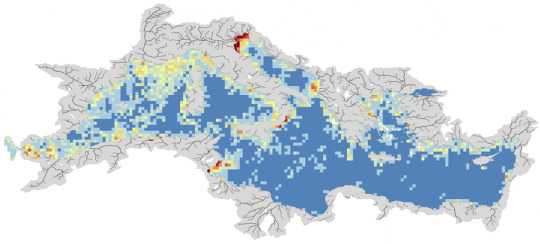
Mediterranean marine litter mapped by satellite, from ESA - Monitoring marine litter from space is now a reality (via Jonty Wareing):
Automation was what made the project possible, harnessing supercomputers and advanced search algorithms. The team found thousands of litter windrows, most more than a kilometre long – and some reaching 20 km in length. The result was the most complete map of marine litter pollution to date.
#image#map#satellite#litter#mediterranean#esa discovery#sentinel-2#copernicus#earth observation#po fluvial system
1 note
·
View note
Text
Strengthen monitoring of the state of the Earth.

The portal is implemented and operated by the European Space Agency and provides a single internet discovery and access point to the ever-growing quantities of heterogeneous collections of Earth observations from satellites, airplanes, drones and in-situ sensors at global, regional and local scales through the Global Earth Observation System of Systems (GEOSS).
The GEOSS is a social and software ecosystem connecting a large array of observing systems, data systems and processing services to strengthen monitoring of the state of the Earth. It facilitates data and information accessibility and interoperability to support the Sustainable Development Goals (SDG) agenda and the Disaster Risk Reduction.
The GEOSS Platform is the cornerstone around which the GEOSS software ecosystem is implemented. The GEOSS Platform is the “glueware” that enables the connection and coordination of the many autonomous and multi-organizational systems and services contributing to GEOSS
#planet earth#blue marble#Earth observation data#EOSS Platform#satellites#airplanes#drones and in-situ sensors#Sustainable Development Goals#Disaster Risk Reduction
1 note
·
View note
Text
According to the MarkNtel Advisors' research report, "Global Satellite-Based Earth Observation Market Analysis, 2021," the market is likely to grow at a CAGR of around 9% during 2021-26. The satellite-based earth observation is for gathering information regarding physical, chemical, and biological aspects of the earth system. The information obtained helps predict & monitor climate patterns, tsunamis, and other natural disasters. It is also beneficial in the agricultural sector, and to detect & assess petroleum & mineral deposits.
#Global Satellite-Based Earth Observation Market#Global Satellite-Based Earth Observation Market Report#Global Satellite-Based Earth Observation Market News#Global Satellite-Based Earth Observation Market Growth
0 notes
Video
Wildfires in Sicily da European Space Agency Tramite Flickr: Wildfires around the city of Palermo in Sicily, Italy, captured by the Landsat-8 mission on 25 July 2023. Data from the mission's SWIR bands, which penetrate the smoke of the fire, has been overlaid on the optical image to provide a clearer view of the fire front and affected area at the time of the acquisition. Credits: USGS/ESA
#ESA#European Space Agency#Space#Space Technology#Earth from Space#Observing the Earth#Earth Observation#Earth Explorer#Satellite image#Wildfires#Sicily#Sicilia#Italy#Italia#Palermo#Fire#Landsat-8#flickr
0 notes
Link
#The Verge#conservation#environment#NASA#climate change#earth observation satellite#Nepal#community#deforestation#aerial#indigenous peoples
0 notes
Text
Black Scientists and Engineers Past and Present Enable NASA Space Telescope
The Nancy Grace Roman Space Telescope is NASA’s next flagship astrophysics mission, set to launch by May 2027. We’re currently integrating parts of the spacecraft in the NASA Goddard Space Flight Center clean room.
Once Roman launches, it will allow astronomers to observe the universe like never before. In celebration of Black History Month, let’s get to know some Black scientists and engineers, past and present, whose contributions will allow Roman to make history.
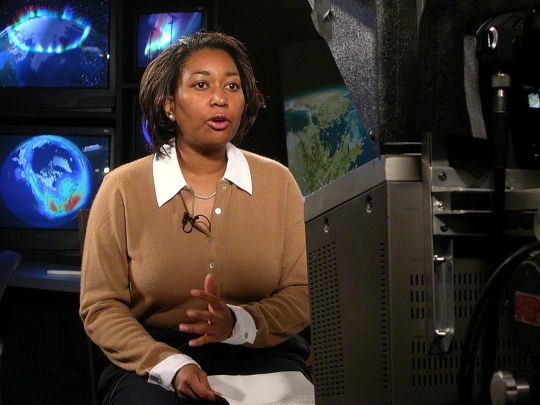
Dr. Beth Brown
The late Dr. Beth Brown worked at NASA Goddard as an astrophysicist. in 1998, Dr. Brown became the first Black American woman to earn a Ph.D. in astronomy at the University of Michigan. While at Goddard, Dr. Brown used data from two NASA X-ray missions – ROSAT (the ROentgen SATellite) and the Chandra X-ray Observatory – to study elliptical galaxies that she believed contained supermassive black holes.
With Roman’s wide field of view and fast survey speeds, astronomers will be able to expand the search for black holes that wander the galaxy without anything nearby to clue us into their presence.

Dr. Harvey Washington Banks
In 1961, Dr. Harvey Washington Banks was the first Black American to graduate with a doctorate in astronomy. His research was on spectroscopy, the study of how light and matter interact, and his research helped advance our knowledge of the field. Roman will use spectroscopy to explore how dark energy is speeding up the universe's expansion.
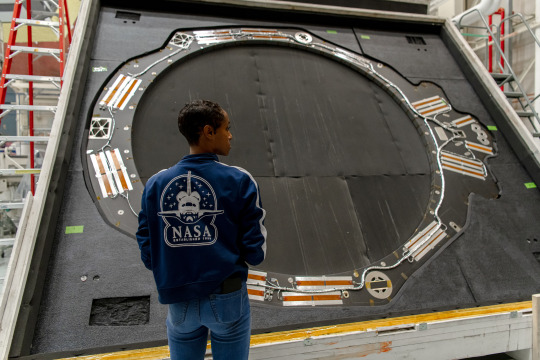
NOTE - Sensitive technical details have been digitally obscured in this photograph.
Sheri Thorn
Aerospace engineer Sheri Thorn is ensuring Roman’s primary mirror will be protected from the Sun so we can capture the best images of deep space. Thorn works on the Deployable Aperture Cover, a large, soft shade known as a space blanket. It will be mounted to the top of the telescope in the stowed position and then deployed after launch. Thorn helped in the design phase and is now working on building the flight hardware before it goes to environmental testing and is integrated to the spacecraft.

Sanetra Bailey
Roman will be orbiting a million miles away at the second Lagrange point, or L2. Staying updated on the telescope's status and health will be an integral part of keeping the mission running. Electronics engineer Sanetra Bailey is the person who is making sure that will happen. Bailey works on circuits that will act like the brains of the spacecraft, telling it how and where to move and relaying information about its status back down to Earth.
Learn more about Sanetra Bailey and her journey to NASA.

Dr. Gregory Mosby
Roman’s field of view will be at least 100 times larger than the Hubble Space Telescope's, even though the primary mirrors are the same size. What gives Roman the larger field of view are its 18 detectors. Dr. Gregory Mosby is one of the detector scientists on the Roman mission who helped select the flight detectors that will be our “eyes” to the universe.
Dr. Beth Brown, Dr. Harvey Washington Banks, Sheri Thorn, Sanetra Bailey, and Dr. Greg Mosby are just some of the many Black scientists and engineers in astrophysics who have and continue to pave the way for others in the field. The Roman Space Telescope team promises to continue to highlight those who came before us and those who are here now to truly appreciate the amazing science to come.
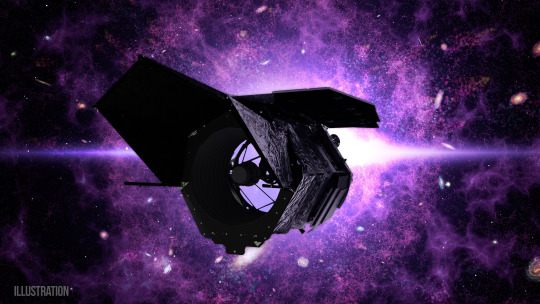
To stay up to date on the mission, check out our website and follow Roman on X and Facebook.
Make sure to follow us on Tumblr for your regular dose of space!
#NASA#astronomy#telescope#Roman Space Telescope#galaxies#black holes#space tech#astrophysics#spectroscopy#STEM#engineering#Black History Month#BlackExcellence365#science#tech#technology
2K notes
·
View notes
Text
Conversation IV - Breaking Boundaries, Space Community; I.D.E.A.S. for Sustainable Development.

Space Science and Technology are becoming increasingly important for attaining the SDGs. Earth observation, weather forecasting, television and communication systems as well as wider scientific field such as Astronomy and Earth Sciences, all rely on GIST, satellite positioning, remote sensing and other technological advances Space science, technology and applications can support a range of pro-developmental activities, inter alia, sustainable cities and agricultural planning, biodiversity protection, tele-medicine and disaster risk management. This conversation will highlight how countries can leverage space science and technologies to achieve the SDGs, specially SDG6 and its nexus, through concrete examples. It will also feature women in space experts with an aim to attract more women and girls to space sciences.
#Space Science#panel discussion#11 february#international Day of Women and Girls in Science#SDG 6#Space technologies#Earth observation#weather forecasting#television and communication systems#Astronomy#Earth Science#remote sensing#Sustainable Development#satellite positioning
0 notes
Text
Dp x dc AU - If the Internation Space Station orbits the Earth 16 times a day, then so does the Watchtower.
Danny’s on track to move out of his parent’s house and move to Gotham for college (He swears that Sam bribed the board to let him in- and she wasn’t even going to that university!) but the dorms don’t open for another three days and he cannot wait to escape. Seeing his parents try to perfect yet another weapon to use against him while he changed out the ecto filters on the portal was too much. He’s completely over the idea of staying when he already has everything packed and ready to go.
The solution? Take all his boxes into his haunt in the Ghost Zone, leave them there and then spend some time in camping in space. He’s already explored the Infinite Realms enough to be bored of it for a minute (not to mention he wants to avoid getting more ‘favors’ to do from Clockwork) and hell, he just wants to see some stars.
He grabs his tent, a sleeping bag and all the food and things he could need and brings it into the atmosphere with him. Keeping it all tethered to him, Danny stays in a fixed position above Gotham (Cause that’s where he’s going next, duh) and treats himself to some quality Me-time.
Only problem is that several times a day he has to make himself intangible while he lets satellites and things pass through. Easy enough and honestly pretty interesting to observe as a wannabe engineering student.
He doesn’t know when exactly it happened the first time- but it turns out the Heroes of Earth all congregated in a satelite office building? It was bigger than the ISS! What the heck!?
Going intangible but not invisible, the JL spot Danny and are incredibly confused how an ‘Alien’ teen just happens to appear in their meeting rooms disappearing at the rate (slowly but surely) of the Watchtower moving through space. Was that camping gear? How was he roasting a marshmallow? Did propane camping stoves even work in space??
16 times a day they get the opportunity to ask Danny a few questions. He mostly ignores them or gives them joke answers. Eventually Martian Manhunter phases through the Watchtower to join him.
They talk about how hard transition periods in life can be and having strained relationships with family. J’ohn returns to the watchtower on its next cycle and reports that the kid is just fine, being an adult is just a hard thing to do.
#dcxdp#dpxdc#dc x dp#dp x dc#Danny Phantom#justice league#watchtower#dc#dc crossover#dc universe#martian manhunter#so much potential for him to haunt them but tbh he just wants to keep looking at the stars#dont ask me how his camping stove works in the vaccum of space google was unhelpful and i failed physics 2#well i mean i passed it eventually but i failed it the first time#thats the energy im bringing and the energy i feel like vibes with danny#the iss moves around earth 16 times a day tho and i think thats neat#martian manhunter is like dude earth relationships are legit so hard and im not just saying that as a refugee#id also like to think that miss martian eventually joins them and danny gets invited to join the YJ
5K notes
·
View notes
Text
NASA Responds to Independent Review of Earth System Observatory
NASA Responds to Independent Review of Earth System Observatory
NASA’s Earth System Observatory will help us better understand what our planet’s changes mean for humanityCredits: NASA NASA shared a response Wednesday on an independent review board established to assess plans and goals for the next generation of Earth-observing satellites: NASA’s Earth System Observatory, a cutting edge suite of spacecraft that will forward understanding of our changing…

View On WordPress
0 notes
Text
On stars, guardians, and Rain World’s cosmology.

One aspect of Rain World lore that’s asked about quite a lot but normally never gets satisfying answers is the topic or Rain World’s space/universe/cosmology. Despite first impressions though, there’s a lot more it than meets the eye, so I thought I would compile most everything we know about it.
For one, to get it out of the way, Rain World isn’t on a planet, and its universe is fundamentally different from our own. This is something Joar has talked about on occasion.
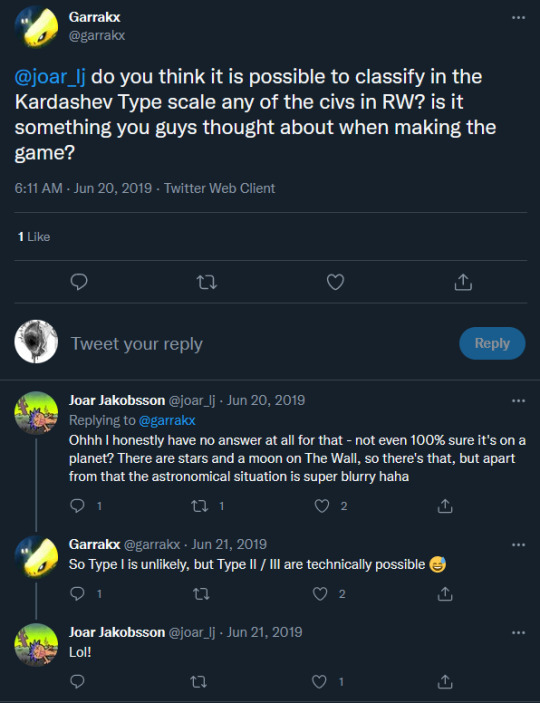
He also said on an earlier dev log how Rain World functions more like a fantasy world where it doesn’t hold much relevance than a real sci-fi like planet.
“Oh, another thing - Rain World isn't a planet lol Cheesy Or I guess it might probably be on a planet, just as Lord of The Rings, Sex And The City, Zelda and Frankenstein's Monster are probably technically on a planet, but just as in those examples the planet aspect isn't really relevant at all. Rain World is more of a fantasy world or a dream world, not somewhere you can go in a space ship ~”
But even if it’s not incredibly relevant, it’s clear a lot of thought was put into Rain Worlds fictional cosmology, this was even mentioned by James.

So, that being said here's what we know about Rain World's cosmology in game.
The biggest indicator of Rain World's unique cosmology is that the Farm Arrays deep pink pearl just mentions celestial spheres, which are aspects of older cosmological models.
"This one is just plain text. I will read it to you. "On regards of the (by spiritual splendor eternally graced) people of the Congregation of Never Dwindling Righteousness, we Wish to congratulate (o so thankfully) this Facility on its Loyal and Relished services, and to Offer our Hopes and Aspirations that the Fruitful and Mutually Satisfactory Cooperation may continue, for as long as the Stars stay fixed on their Celestial Spheres and/or the Cooperation continues to be Fruitful and Mutually Satisfactory." ...May Not as long as the Stars stay fixed on their Celestial Spheres Grey Hand, Impure Blood, Inheritable Corruption, Parasites, or malfunction settle in Your establishment."
More subtly, there's also a mention of the ground colliding with the sky.
"If you leave a stone on the ground, and come back some time later, it's covered in dust. This happens everywhere, and over several lifetimes of creatures such as you, the ground slowly builds upwards. So why doesn't the ground collide with the sky? Because far down, under the very very old layers of the earth, the rock is being dissolved or removed. The entity which does this is known as the Void Sea."
You could chalk this line up to flowery language, but considering the presentation of the rest of the dialogue, it sounds more like an actual aspect of this world.
We know from the Chimney Canopy echo that the sun rises.
"From within my vessel of flesh, I would perch upon this spot to observe the rising of the sun."
And from the top of The Wall we can see the moon and stars (confirmed to be stars by Joar in the previous screenshot, instead of satellites or something else) , which are green!

So, what does this all mean? I think we can entail a few things with what they've given us.
For one, the mention of the ground colliding with the sky implies some sort of firmament, which isn't an unusual concept in the general realm of celestial spheres.
But on the topic of celestial spheres, the pearl actually isn't the only place we see the concept. Guardian halos are very similar to depictions of celestial spheres, and also astrological clocks.

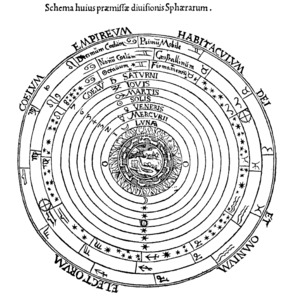
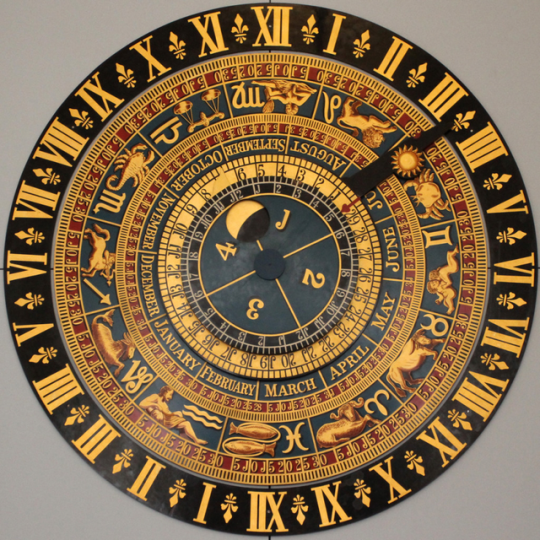
You can make of this as you will, perhaps the astrological references being tied to guardians could hint at the nature of karma, but there isn't much to really delve into that idea.
For what it's worth, celestial spheres are also core concepts in Gnosticism, which Rain World is heavily inspired by. I explain it more in this post about Void Worms, but for a quick synopsis in Gnosticism there are seven planetary spheres, and an eighth above them; the planets and stars are fixed to their spheres. These things just further cement the fact that celestial spheres seem to be a key aspect of Rain World's cosmology, and it would also likely imply it's universe follows a geocentric model.
For a bit of a more out-there theory, people have pointed out how the view atop the wall stretches really far, going far beyond what we could see on a spherical planet like Earth, which has led some to theorize that the world is also flat.
But what is probably the most important aspect of Rain World's cosmology is the nature of dust. Dust builds up, and the bedrock of the world is eaten away at by the Void Sea. Civilizations rise and fall into the sea as new ones are built above it. Many, including myself, believe that the world exists in a sort of state of equilibrium. The world is dissolved from the bottom, then that falls back on the world as dust; even in the final moments of the game we see dust suspended in the void sea depths.

And hey, even void worms are described as being star-like.
"Oh, interesting. This is a diary entry of a pre-Iterator era laborer during the construction of the subterranean transit system south of here. In it they describe restless nights filled with disturbing dreams, where millions glowing stars move menacingly in the distance."
Cyclical, recursive, something else entirely? We can never really pin down the true nature of Rain World's cosmology, but the things we do get hint at something strange and unique. It's such an interesting aspect of the lore, and it seems like Videocult will continue to make mysterious cosmologies in their future projects...


671 notes
·
View notes